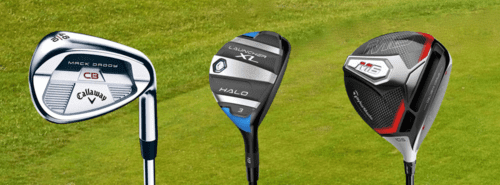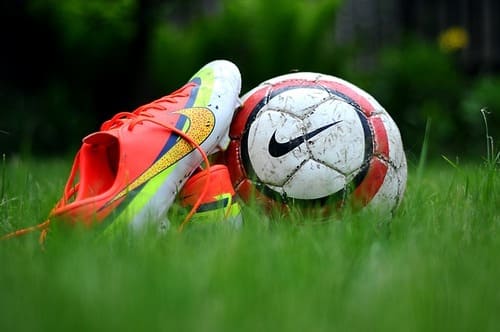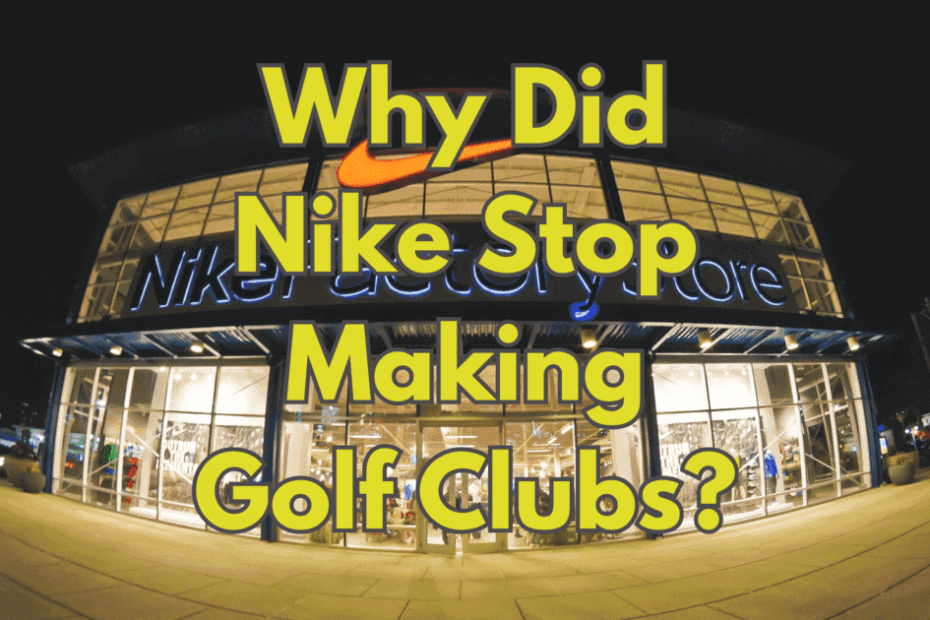Nike burst onto the golf scene in the late 1990s, with hopes to dominate the sport just as it had done in other athletic endeavors. Armed with a lineup of high-profile endorsements and cutting-edge technology, Nike made a splash in the golf club market. But why did Nike stop making golf clubs?
The company’s initial entrance into the golf club market was met with a mix of excitement and skepticism. While some admired Nike’s bold move, others questioned whether a brand known primarily for its footwear and apparel could truly compete in the competitive world of golf equipment.
However, Nike quickly silenced the skeptics when it signed golf sensation Tiger Woods to an endorsement deal in 1996. Woods’ partnership with Nike elevated the brand’s profile exponentially and had a profound impact on their golf club sales. Nike’s clubs became synonymous with Woods’ unparalleled success, and consumers flocked to purchase the same equipment he wielded on the golf course.
This strategic move catapulted Nike’s presence in the golf industry to new heights, and they enjoyed a period of extraordinary growth and popularity.
The Challenges Faced By Nike In The Competitive Golf Club Market
Nike has undeniably faced significant challenges in the fiercely competitive golf club market. One of the primary difficulties that the company encountered was its late entrance into the industry.
While Nike had already established its dominance in the athletic footwear and apparel sector, it struggled to gain a strong foothold in the golf club market. This was largely due to the well-established competition, which had already cultivated a loyal customer base and built strong brand reputations.

Additionally, Nike faced the challenge of appealing to professional golfers and gaining their endorsement. In the early 2000s, Nike’s partnership with the legendary golfer Tiger Woods was seen as a strategic move to boost the company’s golf club sales.
However, despite this high-profile partnership, Nike failed to convert Woods’ success on the golf course into substantial sales of their golf clubs. This highlighted the difficulty of convincing professional golfers and consumers alike that Nike’s clubs could compete with the leading brands in terms of performance and quality.
Nike’s Initial Entrance Into The Golf Club Market
Nike made its highly anticipated entry into the golf club market in the early 2000s, hoping to capitalize on the popularity of the sport and establish a strong presence.
Leveraging its reputation as a leading sports brand, Nike aimed to bring innovation and cutting-edge technology to the golf industry. With a focus on performance and style, Nike introduced a range of golf clubs that attracted considerable attention from both professionals and amateurs alike.
One of the significant moves Nike made during its initial entrance into the golf club market was the signing of golf sensation Tiger Woods as its brand ambassador. This partnership not only brought unmatched visibility to the Nike brand but also generated tremendous excitement among golf enthusiasts.
Capitalizing on Woods’ legendary status as a player and the charisma he exuded both on and off the course, Nike’s golf club sales soared to new heights.
The combination of Nike’s innovative club designs and Woods’ on-course success created an unparalleled synergy that firmly established Nike as a major player in the competitive golf club market.
The Impact Of Tiger Woods’ Partnership With Nike On Their Golf Club Sales
Nike’s partnership with Tiger Woods was a pivotal moment for the company’s golf club sales. Woods, considered one of the greatest golfers of all time, brought immense star power and credibility to Nike’s golfing division.
As a brand ambassador, Woods showcased Nike’s clubs in high-profile tournaments, capturing the attention of golf enthusiasts and professional players alike.

His success on the course resonated with fans, leading to increased demand for Nike’s golf club offerings.
Woods’ influence went beyond his playing ability. Known for his charismatic persona and marketability, he played a significant role in enhancing Nike’s brand image. Golf enthusiasts idolized Woods and sought to emulate his style and technique.
This translated into a positive perception of Nike’s golf clubs, further bolstering their sales. The partnership with Woods undoubtedly played a pivotal role in expanding Nike’s presence in the golf industry, propelling them to the forefront of the market.
The Decline In Consumer Demand For Nike Golf Clubs
One of the major challenges that Nike faced in the golf club market was the decline in consumer demand for their products. Despite initially entering the market with great enthusiasm and marketing efforts, Nike struggled to capture a significant share of the market.
The competition was fierce, with well-established brands dominating the industry and offering a wide range of golf club options. However, Nike’s offerings failed to resonate with consumers, resulting in low sales and a decline in demand.
There are several potential reasons behind the decline in consumer demand for Nike golf clubs. One factor could be the perception that Nike was primarily known for its expertise in athletic footwear and apparel, rather than golf equipment.
This may have created doubt among consumers about the quality and performance of their golf clubs.
Additionally, the brand faced criticism for their unconventional club designs and materials, which might have deterred traditional golfers who preferred more traditional options.
Furthermore, the high price point of Nike’s golf clubs could have also played a role in the decline in demand, as consumers may have found more affordable alternatives from other brands.
The Shift In Nike’s Focus Towards Other Sports Categories
With the ups and downs of their presence in the golf industry, Nike made a strategic decision to shift their focus towards other sports categories. This transition was evident in their marketing efforts and product releases, as they aimed to capitalize on the growing popularity of other sports.
Nike’s decision to shift their focus was driven by various factors, including the pursuit of emerging markets, the rise of other competing brands, and the need to allocate their resources effectively.
One of the primary reasons for Nike’s shift in focus was the presence of potential opportunities in other sports categories. By diverting their attention to these areas, such as basketball, soccer, and running, Nike sought to tap into the increasing global sports market.

This move allowed them to expand their customer base and capitalize on the rising demand for specialized sports equipment and apparel. Furthermore, Nike recognized the potential for greater brand exposure and lucrative sponsorship deals in these sports, which ultimately played a significant role in their strategic decision to shift their focus away from golf.
The Financial Implications Of Discontinuing Nike’s Golf Club Production
The decision to discontinue Nike’s golf club production had significant financial implications for the company. With golf clubs being a major component of Nike’s golf business, the halt in production resulted in a loss of revenue and a decrease in overall profitability.
Nike had invested heavily in the development and marketing of its golf clubs, including endorsements from top professional golfers. However, the decline in consumer demand for Nike golf clubs, coupled with the intense competition in the golf club market, led the company to cease production in this category.
The financial impact of discontinuing golf club production extended beyond just the revenue loss. Nike also had to deal with the cost of discontinuation, including the write-down of excess inventory, termination of contracts with professional golfers, and potential job cuts within the golf division.
Furthermore, the decision to exit the golf club industry raised concerns among investors about Nike’s ability to maintain a strong presence in the golf equipment market going forward.
As the company redirected its focus towards other sports categories, the financial implications of discontinuing golf club production highlighted the challenges faced by Nike in establishing a strong foothold in this particular industry.
The Reaction Of Professional Golfers To Nike’s Exit From The Market
Professional golfers were taken aback by Nike’s sudden exit from the golf club market. Many players had been loyal endorsers of Nike golf clubs and had developed a deep connection with the brand.
However, with the announcement of Nike’s departure, these golfers were left in a state of uncertainty. Without the support and partnership of a major equipment manufacturer, they faced the challenge of finding alternative club options that suited their game and preferences.
Some professional golfers were vocal about their disappointment and expressed concerns about the impact of Nike’s departure on the overall golf industry.
They believed that Nike’s presence in the market had contributed to healthy competition and innovation, pushing other manufacturers to constantly improve their products. With the absence of Nike’s golf clubs, these athletes worried that the industry might become stagnant, which could potentially hinder the growth and development of the sport as a whole.
Nonetheless, others remained optimistic, focusing on the opportunity for new brands to emerge and fill the void left by Nike’s departure, ultimately leading to a more diversified and competitive market.
Reasons Nike Struggled To Establish A Strong Foothold In The Golf Club Industry
One potential reason behind Nike’s struggle to establish a strong foothold in the golf club industry can be attributed to intense competition. The golf club market is highly competitive, with several well-established brands already dominating the industry.
Competing with established and trusted brands like Callaway, TaylorMade, and Titleist can be quite challenging for a relatively new entrant like Nike. These competitors have years of experience, dedicated customer bases, and a reputation for producing high-quality golf clubs, making it difficult for Nike to penetrate the market.

Another potential reason for Nike’s struggle in the golf club industry could be the company’s late entry into the market. While Nike is known for its dominance in the athletic footwear and apparel sectors, it entered the golf club market relatively late.
By the time Nike launched its golf club product line in the late 1990s, several other well-established brands had already established themselves as leaders in the industry. The late entry may have made it difficult for Nike to gain a significant market share and establish itself as a top contender in the golf club market.
The Future Prospects For Nike In The Golf Equipment Market
Nike’s future prospects in the golf equipment market remain uncertain as the industry continues to evolve. Despite their decision to discontinue golf club production in 2016, Nike has not completely abandoned the sport. Instead, they have shifted their focus towards other areas within the golf equipment market, such as apparel and footwear.
One potential avenue for Nike’s future success lies in their ability to leverage their brand recognition and reputation in the larger sports industry. With their strong presence in basketball, running, and other sports, Nike has the opportunity to cross-promote their golf equipment offerings to their wide customer base.
By capitalizing on their existing partnerships with athletes and their innovative design capabilities, Nike may be able to re-establish themselves as a relevant player in the golf equipment market.
However, Nike still faces significant challenges in rebuilding their presence in the golf equipment market. The competition within the industry is fierce, with well-established brands like Callaway and TaylorMade dominating the market. Additionally, consumer demand for golf equipment has been fluctuating in recent years, making it more difficult for Nike to gain a substantial market share.
The future prospects for Nike in the golf equipment market will greatly depend on their ability to adapt and innovate. By focusing on their core strengths, leveraging their existing brand and athlete partnerships, and closely monitoring the evolving landscape of the industry, Nike has a chance to regain their footing and become a key player once again.
Only time will tell if Nike can rise to the challenge and successfully establish themselves in the ever-changing golf equipment market.
FAQs
What Led To Nike’s Decline In The Golf Industry?
Nike’s decline in the golf industry can be attributed to a combination of factors, such as increased competition in the golf club market, a decrease in consumer demand for Nike golf clubs, and a shift in the company’s focus towards other sports categories.
How Did Tiger Woods’ Partnership With Nike Impact Their Golf Club Sales?
Tiger Woods’ partnership with Nike initially had a positive impact on their golf club sales. His endorsement of Nike golf clubs helped to increase brand visibility and attract customers. However, as Woods’ performance declined, the impact on sales became less significant.
Why Did Nike Shift Its Focus Towards Other Sports Categories?
Nike shifted its focus towards other sports categories due to the challenges faced in the golf club market. With declining sales and strong competition, Nike decided to allocate resources to sports categories where they could achieve greater success and profitability.
What Were The Financial Implications Of Discontinuing Nike’s Golf Club Production?
Discontinuing Nike’s golf club production had financial implications for the company. They had to write off inventory, incur costs related to the discontinuation process, and potentially face a decrease in revenue from the golf equipment segment.
How Did Professional Golfers React To Nike’s Exit From The Market?
Professional golfers had mixed reactions to Nike’s exit from the market. Some players who were sponsored by Nike had to find new equipment sponsors, while others saw it as an opportunity to explore different brands and technologies.
Why Did Nike Struggle To Establish A Strong Foothold In The Golf Club Industry?
There are several potential reasons behind Nike’s struggle to establish a strong foothold in the golf club industry. These include intense competition from well-established brands, a lack of innovation in their club designs, and the association of Nike primarily with other sports rather than golf.
What Are The Future Prospects For Nike In The Golf Equipment Market?
The future prospects for Nike in the golf equipment market are uncertain. While they have discontinued their golf club production, they still have a presence in other golf categories such as apparel and footwear. It remains to be seen if they will make a comeback in the club market or focus on their strengths in other areas.





